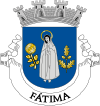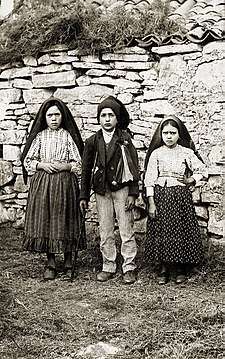Fátima, Portugal
| Fátima | |||
|---|---|---|---|
| Civil parish | |||
 The Sanctuary of Our Lady of Fátima, ex-libris of the city, the Calvary in Valinhos and the main avenue in Cova da Iria | |||
| |||
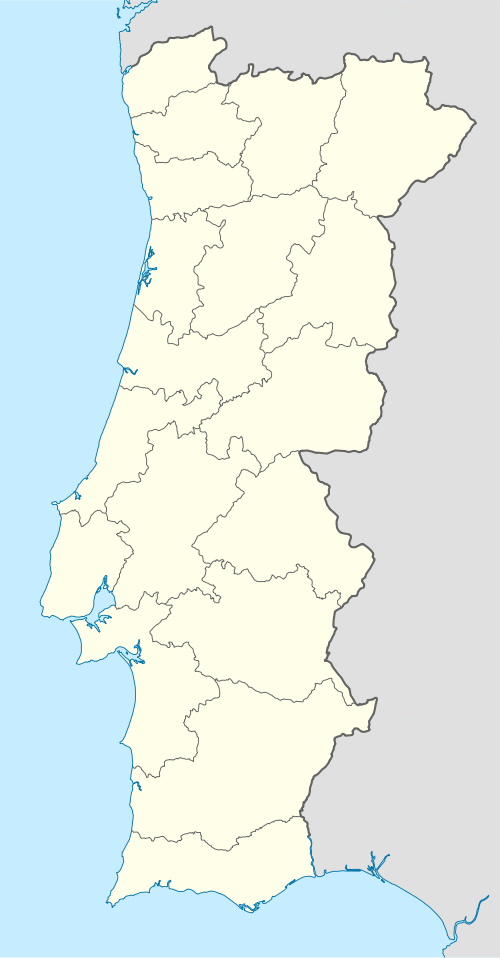 Fátima | |||
| Coordinates: 39°37′31″N 8°39′57″W / 39.62528°N 8.66583°W | |||
| Country | Portugal | ||
| Region | Central Portugal | ||
| Subregion | Middle Tagus | ||
| Intermunic. comm. | Middle Tagus | ||
| District | Santarém | ||
| Municipality | Ourém | ||
| Area | |||
| • Total | 71.84 km2 (27.74 sq mi) | ||
| Elevation | 350 m (1,150 ft) | ||
| Population (2011) | |||
| • Total | 11,596 | ||
| • Density | 160/km2 (420/sq mi) | ||
| Postal code | 2495 Fátima | ||
| Area code | 249 | ||
| Patron |
Our Lady of Pleasures Our Lady of Fátima | ||
| Website | www.freguesiadefatima.pt | ||
Fátima (Portuguese pronunciation: [ˈfatimɐ] (![]()
The civil parish has been permanently associated with the Marian apparitions that were purportedly witnessed by three local shepherd children at the Cova da Iria in 1917. The Catholic Church later recognized these events as "worthy of belief". A small chapel was built at the site of the apparition, now known as Our Lady of Fátima, beginning in 1918, and a statue of her installed. The chapel and statue have since been enclosed within the Sanctuary of Our Lady of Fátima, a shrine complex containing two minor basilicas that are visited by thousands of pilgrims each year. Associated facilities for pilgrims, including a hotel and medical centre, have also been built over the decades within and around the Sanctuary.
History
The name of the town and parish is a rendition of the Arabic given name Fátima (فاطمة Fāṭimah). (Fatimah is the namesake of Fatimah bint Muhammad, a daughter of the prophet of Islam Muhammad.)
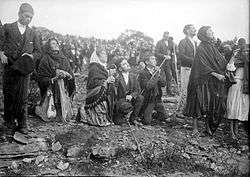

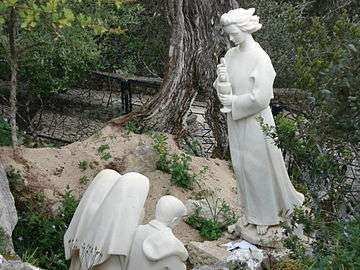
.jpg)
Fátima was said to be the name of a Moorish princess kidnapped by a knight, Gonçalo Hermigues, and his companions. Hermigues took her to a small village in the Serra de Aire hills, in the recently created Kingdom of Portugal. According to the Western Catholic narrative, Fatima fell in love with her kidnapper and decided to convert to Christianity in order to marry him. She was baptized and given a Christian name, Oureana.[2]
Arab sources, however, claim that Fátima was forced into Christianity,[3] as were most Reconquista captives. There is no documentary evidence to support either scenario of such a conversion.
Whatever version is true, the place name recalls the Princess' original Arab name rather than her Christian baptismal one.
The parish was founded in 1568, when it was annexed by the Collegiate of Ourém (Portuguese: Colegiada de Ourém). For centuries, most of the villagers kept herds of sheep and depended also on subsistence farming.[4]
Since the early 20th century, Fátima has been associated with events in which three local children, Lúcia dos Santos and her cousins, Francisco and Jacinta Marto, purportedly saw visions of a woman known as Our Lady of Fátima, since believed by the Catholic Church to be the Virgin Mary. On 13 May 1917, whilst guarding their families' sheep in the Cova da Iria, the children first claimed to have seen an apparition of a "lady dressed in white" and shining with a bright light.[5][4]
The three shepherd children were born in Aljustrel, a small hamlet about 1 kilometre (0.62 mi) from Fátima.[6] To the west, near Aljustrel, is Loca do Cabeço, a smaller agglomeration of rocky outcroppings where, in 1916, an angel purportedly appeared twice to the three children.[6] The children claimed to have seen the Marian apparition on six occasions; they said the last would be 13 October 1917.[4] An estimated 70,000 pilgrims went to the site for the last prophesied apparition in October. Some of them reported what has been referred to as the Miracle of the Sun, when some observers reported it appeared to be behaving unusually.[5][4]
The local bishop investigated the events and determined that the apparitions were worthy of belief. The site was marked by a cross erected by locals. In 1918 they built a small chapel, built from rock and limestone and covered in tile. It was 3.3 metres (11 ft) by 2.8 metres (9.2 ft) length, and 2.85 metres (9.4 ft) height. It became a centre for Marian devotion, receiving names such as a fé de Fátima, cidade da Paz ("the faith of Fátima, City of Peace"), or Terra de Milagres e Aparições ("Land of Miracles and Apparitions").[4]
The chapel has since been enclosed within a large basilica and sanctuary, part of a complex including a hotel and other facilities.[5][4] In 1930, the statue of Our Lady in the Chapel of Apparitions was crowned by the Vatican.
Francisco died in 1919 and Jacinta in 1920, during the international Spanish flu pandemic. Lucia dos Santos became a nun and lived until 2005.[5][4] The two who died young were beatified on 13 May 2000 by Pope John Paul II,[5] and were canonised by Pope Francis on 13 May 2017, the hundredth anniversary of the first apparition.[7]
The construction of the sanctuary and the steady visits by pilgrims stimulated local development. In addition to construction of a large shrine, basilica, and sanctuary, the complex includes a hotel and other facilities. The town of Fátima was elevated to the status of city on 12 July 1997.[6]
In the early 21st century, numerous residents of the parish (primarily from its business sector) worked to have Fátima designated as an independent municipality. The project, led by Júlio Silva, engineer and ex-president of the Junta de Freguesia (Parish Council), was vetoed on July 2003 by President of Portugal Jorge Sampaio.[6]
Geography
Fátima is located on the Estremenho Limestone Massif, on the flanks of the Serra de Aire, approximately 350 metres (1,150 ft) above sea level. The geology of the Serras de Aire and Candeeiros gives rise to an arid landscape with a rocky ground interspersed with limestone outcroppings.[6] There are various geological formations in the region including sinkholes, uvalas and polje (like the Polje de Minde-Mata), as well as karst grottoes, caves with stalactites and stalagmites, in addition to lapiez fields.[6]
The climate is characterized by heavy precipitation during the winter, with approximately 900 millimetres (35 in) annually, and warm, dry summers.[6]
The trees in this area are primarily dominated by holly oak (Quercus ilex), Portuguese oak (Quercus faginea), strawberry trees (Arbutus unedo), buckthorn and olive trees, all of which are resistant to the precipitation extremes of the climate. There are also areas of savannah, strips of land bounded by walls of loose stone.[6]
The parish contains the following localities: Aljustrel, Alvaijar, Amoreira, Boleiros, Casa Velha, Casal Farto, Chã, Charneca, Cova da Iria, Eira da Pedra, Fátima, Giesteira, Lombo da Égua, Maxeira, Moimento, Moita Redonda, Moitas, Montelo, Pederneira, Poço de Soudo, Ramila, Vale de Cavalos and Valinho de Fátima.
Twin towns — Sister cities
Fátima is twinned with:
Economy
.jpg)
The economy of the town relies on religious tourism because the world devotion through Our Lady of Fátima attracts millions of Christian pilgrims. The locals have numerous shops and stalls devoted to the sale of religious articles and souvenirs. In addition, services for tourists, hotels, restaurants and other retail also benefit from the visitors. Other economic activities in the region include: marble sculpturing, saw-milling, carpentry, civil construction, commerce, and services.
Architecture
Civic
.jpg)
.jpg)
- Bus station of Fátima (Portuguese: Estação Rodoviária de Fátima)
- Cistern of Gaiola (Portuguese: Cisterna em Gaiola)
- Cistern of Ramila (Portuguese: Cisterna em Ramila)
- Cistern of Capuchos (Portuguese: Cisterna dos Capuchos)
- Civil Parish Building of Fátima (Portuguese: Junta de Freguesia de Fátima)
- Fountain of Alveijar (Portuguese: Fonte do Alveijar)
- Fountain of Lameira (Portuguese: Fonte da Lameira)
- Fountain of Soudo Well (Portuguese: Fonte em Poço de Soudo)
- Fountain of Vale da Pena (Portuguese: Fonte do Vale da Pena)
- Fountain New (Portuguese: Fonte Nova)
- House of Casal Farto (Portuguese: Casa de Casal Farto)
- Main avenue of Fátima (Portuguese: Avenida de Dom José Alves Correia da Silva)
- Mills of Fátima (Portuguese: Moinhos de Fátima)
- Mills of Fazarga (Portuguese: Moinhos da Fazarga)
- Mills of Giesteira (Portuguese: Moinhos da Giesteira)
- Mill of Ortiga (Portuguese: Moinho da Ortiga)
- Monument of the Three Little Shepherds (Portuguese: Monumento dos Pastorinhos - Rotunda Sul de Fátima)
- Old mill of Ramila (Portuguese: Moinho Arruinado em Ramila)
- Olive Oil Press in Estrada das Matas (Portuguese: Lagar de azeite na Estrada das Matas)
- Porch House with Sundial (Portuguese: Casa Alpendrada com relógio de Sol em Casal Farto)
- Residence of Francisco and Jacinta Marto, visionaries of Fátima (Portuguese: Casa de Francisco e Jacinta Marto, videntes de Fátima)
- Residence of Lúcia dos Santos (Portuguese: Casa de Lúcia dos Santos, vidente de Fátima)
- Threshing-floor of Ramila (Portuguese: Eira em Ramila)
Religious

_-_Jul_2008.jpg)
.jpg)
.jpg)
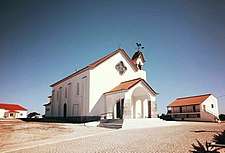
- Chapel of Casal Farto (Portuguese: Capela de Casal Farto)
- Chapel of Lombo de Égua (Portuguese: Capela de Lombo de Égua)
- Chapel of Our Lady of Conception (Portuguese: Capela da Amoreira/Capela de Nossa Senhora da Conceição)
- Church of Our Lady of Livramento (Portuguese: Capela de Boleiros/Igreja de Nossa Senhora do Livramento)
- Church of Saint Anthony (Portuguese: Igreja Paroquial de Fátima / Igreja Paroquial de Santo António)
- Basilica of the Holy Trinity (Portuguese: Basílica da Santíssima Trindade), on the far side of the sanctuary's esplanade is the basilica, a neo-classical structure with a central tower 65 meters (213 ft) high, which was begun on 13 May 1928. It is flanked by colonnades linking it with the extensive convent and hospital buildings. Within the basilica are the tombs of the three witnesses to the apparitions: Jacinta and Francisco Marto and Lúcia dos Santos. The Church of the Holy Trinity, one of the largest churches in the world, was built on the other side of the esplanade in the early 21st century.
- Sanctuary of Fátima (Portuguese: Santuário de Fátima)
- Chapel of the Apparitions (Portuguese: Capelinha das Aparições)
- Basilica of Our Lady of the Rosary (Portuguese: Basílica de Nossa Senhora do Rosário)
- Sanctuary of Our Lady of Ortiga (Portuguese: Santuário de Nossa Senhora da Ortiga)
- Parochial church of Fátima (Portuguese: Igreja Paroquial de Fátima)
- Stations of the Cross of Valinhos (Portuguese: Via Sacra dos Valinhos)
- Statues of the Angel of Portugal (Portuguese: Estátua do Anjo de Portugal na Loca do Cabeço e no Poço do Arneiro)
- Chapel of Saint Stephen of Hungary (Portuguese: Capela de Santo Estevão)
Culture
The Sanctuary of Our Lady of Fátima, in Cova da Iria, is the principal focus of all visitors. Annually, at least five millions of Catholic pilgrims regularly fill the country roads leading to the Marian shrine. Numbers can reach hundreds of the thousands on 13 May and 13 October, the most significant dates of the apparitions in Fátima.[9]
Sports
Fátima's major sports club is the Sport Center of Fátima, currently in Portuguese football's second tier, the LigaPro.
See also
- Angelus TV – a Catholic television network based in Fátima
- Our Lady of the Rosary of Fátima
- Sanctuary of Fátima
- Chapel of the Apparitions
- Cova da Iria
References
- ↑ Instituto Nacional de Estatística (INE), Census 2011 results according to the 2013 administrative division of Portugal
- ↑ "How Fatima Came To Be". www.holymary.info.
- ↑ "القديسـة فـاطمـة Saint Fatima". www.iraker.dk.
- 1 2 3 4 5 6 7 Junta de Freguesia de Fátima, ed. (2018), History, Fátima (Ourém), Portugal, retrieved 2 February 2018
- 1 2 3 4 5 Walsh, William Thomas (1 October 1954), Our Lady of Fátima, Random House, ISBN 978-0385028691
- 1 2 3 4 5 6 7 8 Junta Freguesia, ed. (2011), Caracterização (in Portuguese), Fátima (Ourém), Portugal, retrieved 12 October 2012
- ↑ "Pope Francis canonises two children at Portugal's Fatima shrine". BBC. BBC. 13 May 2017. Retrieved 13 May 2017.
- 1 2 3 4 5 "Association of Towns awarded The Europe Prize". www.czestochowa.um.gov.pl. Retrieved 2009-10-10.
- ↑ Trudy Ring (1996), p.245
- Ring, Trudy (1996), International Dictionary of Historic Places, ISBN 978-1-884964-02-2
External links
| Wikimedia Commons has media related to Fátima. |
| Wikivoyage has a travel guide for Fátima. |
- City Hall of Fátima – Official website
- Sanctuary of Fátima – Online transmissions
- Pilgrims of Fátima – Official website
- Free online version of the book: "Fátima in Sister Lúcia’s own words"
- Video documentary: Portugal in 150 seconds: Fátima

